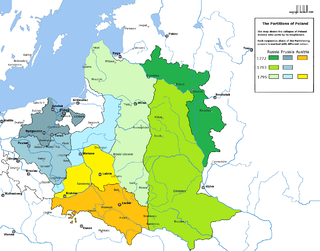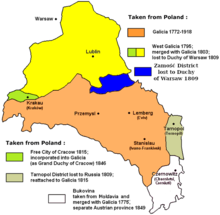History
After the failed Kościuszko Uprising of 1794, Emperor Francis II of Habsburg agreed with Empress Catherine II of Russia to again divide and thereby completely abolish the remaining Polish–Lithuanian Commonwealth, a decision which Prussia joined on 24 October 1795. The Habsburg Monarchy, which had not participated in the Second Partition, now received a share that comprised the lands north of the Kingdom of Galicia and Lodomeria gained in the First Partition of 1772. The Habsburg Monarchy then occupied the entirety of Lesser Poland, stretching along the upper Vistula river to the outskirts of Praga and Warsaw, the tributaries of the Bug and the Pilica forming the northern border with New East Prussia.
In 1803, it was merged with the Kingdom of Galicia and Lodomeria, but retained some autonomy. It remained a territory of the Austrian Empire even when, in 1807, Napoleon I of France created the Duchy of Warsaw from territories in Greater Poland which Prussia had annexed in the Second and Third Partition and now was forced to renounce according to the Treaty of Tilsit. Austria lost New Galicia in the 1809 War of the Fifth Coalition, after a corps under Archduke Ferdinand Karl Joseph of Austria-Este on 15 April 1809 started the Polish–Austrian War by invading the Duchy of Warsaw. Despite the archduke's plans to move in as a national liberator, he was challenged by the forces of Prince Józef Poniatowski at the Battle of Raszyn. Austria was finally defeated at the Battle of Wagram on 6 July, whereafter New Galicia was attached to the Duchy of Warsaw by the Treaty of Schönbrunn.
With the Final Act of the Vienna Congress in 1815, the territory became part of Congress Poland, ruled in personal union by Emperor Alexander I of Russia, while Kraków nominally retained its independence as the Free City of Kraków.

The Partitions of Poland were three partitions of the Polish–Lithuanian Commonwealth that took place toward the end of the 18th century and ended the existence of the state, resulting in the elimination of sovereign Poland and Lithuania for 123 years. The partitions were conducted by the Habsburg monarchy, the Kingdom of Prussia, and the Russian Empire, which divided up the Commonwealth lands among themselves progressively in the process of territorial seizures and annexations.

From 1795 to 1918, Poland was split between Prussia, the Habsburg monarchy, and Russia and had no independent existence. In 1795 the third and the last of the three 18th-century partitions of Poland ended the existence of the Polish–Lithuanian Commonwealth. Nevertheless, events both within and outside the Polish lands kept hopes for restoration of Polish independence alive throughout the 19th century. Poland's geopolitical location on the Northern European Lowlands became especially important in a period when its expansionist neighbors, the Kingdom of Prussia and Imperial Russia, involved themselves intensely in European rivalries and alliances as modern nation-states took form over the entire continent.

The Duchy of Warsaw, also known as the Grand Duchy of Warsaw and Napoleonic Poland, was a French client state established by Napoleon Bonaparte in 1807, during the Napoleonic Wars. It initially comprised the ethnically Polish lands ceded to France by Prussia under the terms of the Treaties of Tilsit, and was augmented in 1809 with territory ceded by Austria in the Treaty of Schönbrunn. It was the first attempt to re-establish Poland as a sovereign state after the 18th-century partitions and covered the central and southeastern parts of present-day Poland.

Galicia is a historical and geographic region spanning what is now southeastern Poland and western Ukraine, long part of the Polish–Lithuanian Commonwealth. It covers much of the other historic regions of Red Ruthenia and Lesser Poland.

South Prussia was a province of the Kingdom of Prussia from 1793 to 1807.

The Free, Independent, and Strictly Neutral City of Cracow with its Territory, more commonly known as the Free City of Cracow, and the Republic of Cracow, was a city republic created by the Congress of Vienna in 1815, which included the Polish city of Cracow and its surrounding areas.

The Kingdom of Galicia and Lodomeria, also known as Austrian Galicia or colloquially Austrian Poland, was a constituent possession of the Habsburg monarchy in the historical region of Galicia in Eastern Europe. The crownland was established in 1772. The lands were annexed from the Polish-Lithuanian Commonwealth as part of the First Partition of Poland. In 1804 it became a crownland of the newly proclaimed Austrian Empire. From 1867 it was a crownland within the Cisleithanian or Austrian half of the dual monarchy of Austria-Hungary. It maintained a degree of provincial autonomy. Its status remained unchanged until the dissolution of the monarchy in 1918.

Lodomeria is the Latinized name of Volodymyr, a Ruthenian principality also referred to as the Principality of Volhynia, which was founded by the Rurik dynasty in 987 in the western parts of Kievan Rus'. It was centered on the region of Volhynia, straddling the borders of modern-day Poland, Ukraine and Belarus. The Principality of Volodymyr arose in the course of the 12th century along with the Principality of Halych.

The Habsburg monarchy, also known as Habsburg Empire, was the collection of empires, kingdoms, duchies, counties and other polities that were ruled by the House of Habsburg. From the 18th century it is also referred to as the Danubian monarchy or the Austrian monarchy.

The Third Partition of Poland (1795) was the last in a series of the Partitions of Poland–Lithuania and the land of the Polish–Lithuanian Commonwealth among Prussia, the Habsburg monarchy, and the Russian Empire which effectively ended Polish–Lithuanian national sovereignty until 1918. The partition was the result of the Kościuszko Uprising and was followed by a number of Polish uprisings during the period.

Austrian Silesia, officially the Duchy of Upper and Lower Silesia, was an autonomous region of the Kingdom of Bohemia and the Habsburg monarchy. It is largely coterminous with the present-day region of Czech Silesia and was, historically, part of the larger Silesia region.

The Kingdom of Galicia and Lodomeria, a crown land of Austria-Hungary, was subdivided into political districts for administrative purposes, which were referred to in Polish as powiaty. When they were introduced in 1867 there were 74 of these administrative counties; in 1900 there were 78 counties. The administrative counties were responsible for storing vital records. These counties were introduced following the 1867 December Constitution.

The Grand Duchy of Kraków was created after the incorporation of the Free City of Cracow into Austria on November 16, 1846. From 1846 to 1918 the title, Grand Duke of Kraków, was part of the official titulary of the Emperor of Austria.

Following three consecutive partitions of Poland carried out between 1772 and 1795, the sovereign state known as the Polish–Lithuanian Commonwealth disappeared from the map of Europe. In 1918 following the end of World War I, the territories of the former state re-emerged as the states of Poland and Lithuania among others. In the intervening period, the territory of the former Polish–Lithuanian Commonwealth was split between the Austrian Empire, the Kingdom of Prussia and the Russian Empire. These powers subdivided the territories that they gained and created new toponyms for the territories conquered. The subdivisions created were complicated by changes within those empires as well as by the periodic establishment of other forms of the quasi-Polish provinces led by a foreign head of state.

The Austrian Partition comprises the former territories of the Polish–Lithuanian Commonwealth acquired by the Habsburg monarchy during the Partitions of Poland in the late 18th century. The three partitions were conducted jointly by the Russian Empire, the Kingdom of Prussia and Habsburg Austria, resulting in the complete elimination of the Polish Crown. Austria acquired Polish lands during the First Partition of 1772, and Third Partition of Poland in 1795. In the end, the Austrian sector encompassed the second-largest share of the Commonwealth's population after Russia; over 2.65 million people living on 128,900 km2 of land constituting the formerly south-central part of the Republic.
Polish historic regions are regions that were related to a former Polish state, or are within present-day Poland, with or without being identified in its administrative divisions.

Three Emperors' Corner is a former tripoint at the confluence of the Black and White Przemsza rivers, near the towns of Mysłowice, Sosnowiec and Jaworzno in the present-day Silesian Voivodeship of Poland. During the Partitions of Poland, from 1871 to 1918, it marked the place at which the borders of three empires that had divided Poland – the Russian Empire, Austria-Hungary and the German Empire – met.

Throughout its existence, from 1772 to 1918, the Kingdom of Galicia and Lodomeria, used three flag designs to represent itself.
With the arrival of the Hungarians into the heart of the Central European Plain around 899, Slavic tribes of Vistulans, White Croats, and Lendians found themselves under Hungarian rule. In 955 those areas north of the Carpathian Mountains constituted an autonomous part of the Duchy of Bohemia and remained so until around 972, when the first Polish territorial claims began to emerge. This area was mentioned in 981, when Vladimir the Great of Kievan Rus' claimed the area on his westward way. In the 11th century the area belonged to Poland, then reverted to Kievan Rus'. However, at the end of the 12th century the Hungarian claims to the principality turned up. Finally Casimir III of Poland annexed it in 1340–1349. Low Germans from Prussia and Middle Germany settled parts of northern and western Galicia from the 13th to 18th centuries, although the vast majority of the historic province remained independent from German and Austrian rule.

The grand title of the emperor of Austria was the official list of the crowns, titles, and dignities which the emperors of Austria carried from the foundation of the empire in 1804 until the end of the monarchy in 1918.
















